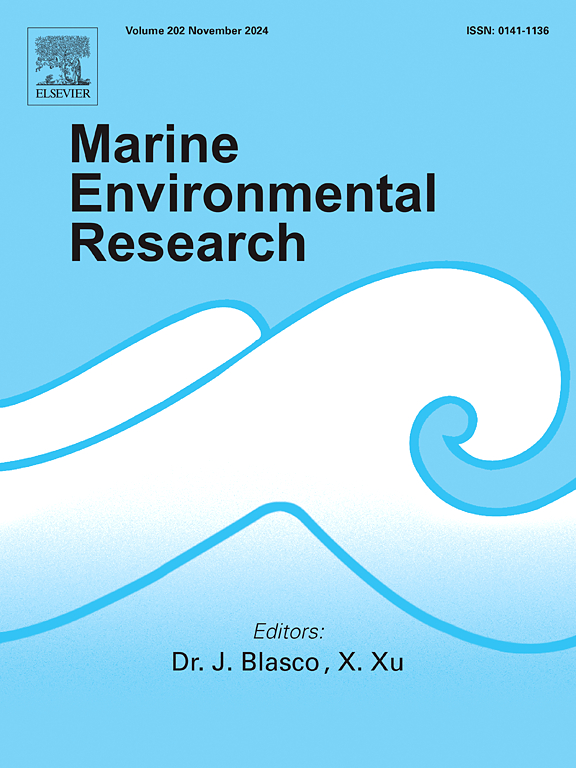夜间人工照明(ALAN)改变了沙滩等足类动物的行为和生理机能。这些影响是可逆的吗?
IF 3
3区 环境科学与生态学
Q2 ENVIRONMENTAL SCIENCES
引用次数: 0
摘要
夜间人造光(ALAN)正在成为陆地和海洋栖息地普遍存在的压力源,对行为和生理依赖自然光/暗循环的物种构成威胁。虽然有许多研究研究了ALAN的生物学影响,但很少有研究调查生物体从这种应激源中恢复的能力。本研究以沙滩等足类动物Tylos spinulosus为模型物种,评估ALAN的短期效应及其在去除光源后的潜在恢复。为了实现这一点,我们进行了单独的实验室实验来评估ALAN暴露和恢复期间运动活动、食物消耗、食物吸收效率和生长速度的变化。我们将恢复定义为测量的反应在偏离ALAN条件下同一个体的记录后在统计上恢复到控制水平的状态。结果表明,ALAN对所有四个变量都有不利影响。虽然在去除ALAN后,食物消耗和生长恢复到控制水平,但活性和吸收效率却没有,这表明在试验的时间框架内缺乏恢复。这些结果表明,该物种从短期光污染暴露中恢复在很大程度上取决于所研究的行为或生理反应。因此,建议在更长期的实验中进行更广泛的反应,以更好地了解该物种在与管理相关的时间尺度上从光污染中恢复的能力。本文章由计算机程序翻译,如有差异,请以英文原文为准。
Artificial Light at Night (ALAN) alters the behavior and physiology of a sandy beach isopod. Are these effects reversible?
Artificial Light at Night (ALAN) is becoming a pervasive stressor in both terrestrial and marine habitats, posing a threat to species whose behavior and physiology rely on natural light/dark cycles. While numerous studies have examined the biological impacts of ALAN, far fewer have investigated the ability of organisms to recover from this stressor. This study used the sandy beach isopod Tylos spinulosus as a model species to assess the short-term effects of ALAN and its potential recovery following the removal of light sources. To achieve this, we conducted separate laboratory experiments to evaluate changes in locomotor activity, food consumption, food absorption efficiency, and growth rates under ALAN exposure and during recovery. We defined recovery as the state in which the measured responses statistically returned to control levels after deviating from those recorded for the same individuals under ALAN conditions. The results showed that ALAN had a detrimental effect on all four variables. While food consumption and growth returned to control levels after ALAN removal, activity and absorption efficiency did not, indicating a lack of recovery within the timeframe of the trials. These results suggest that the recovery of this species from short-term light pollution exposure is heavily dependent on the behavioral or physiological responses under examination. Hence, a broader range of responses over longer-term experiments are suggested to better understand the ability of this species to recover from light pollution at time scales relevant to management.
求助全文
通过发布文献求助,成功后即可免费获取论文全文。
去求助
来源期刊

Marine environmental research
环境科学-毒理学
CiteScore
5.90
自引率
3.00%
发文量
217
审稿时长
46 days
期刊介绍:
Marine Environmental Research publishes original research papers on chemical, physical, and biological interactions in the oceans and coastal waters. The journal serves as a forum for new information on biology, chemistry, and toxicology and syntheses that advance understanding of marine environmental processes.
Submission of multidisciplinary studies is encouraged. Studies that utilize experimental approaches to clarify the roles of anthropogenic and natural causes of changes in marine ecosystems are especially welcome, as are those studies that represent new developments of a theoretical or conceptual aspect of marine science. All papers published in this journal are reviewed by qualified peers prior to acceptance and publication. Examples of topics considered to be appropriate for the journal include, but are not limited to, the following:
– The extent, persistence, and consequences of change and the recovery from such change in natural marine systems
– The biochemical, physiological, and ecological consequences of contaminants to marine organisms and ecosystems
– The biogeochemistry of naturally occurring and anthropogenic substances
– Models that describe and predict the above processes
– Monitoring studies, to the extent that their results provide new information on functional processes
– Methodological papers describing improved quantitative techniques for the marine sciences.
 求助内容:
求助内容: 应助结果提醒方式:
应助结果提醒方式:


